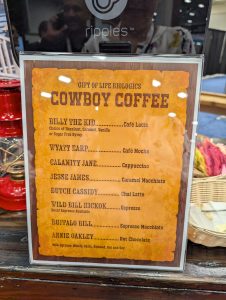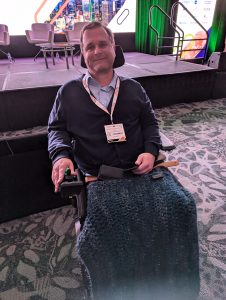
Although cowboys were scarce in Dallas, cowboy coffee was a fun treat in the exhibition hall at ATW25
In a new location, with highways replacing waterways, it’s comforting to have an agenda with some consistent touchpoints for familiarity, and Advanced Therapies Week 2025 (ATW25), January 20-23 in Dallas, Texas, began with two of my favourites: the Super plenary, moderated by Anthony Davies, Dark Horse Consulting Group, and the Opening plenary, featuring Susan Nichols, Propel Biosciences. I will get to both in a moment.
I’ve had the good fortune to attend this conference since it moved to Florida many years ago. It attracts top leaders in the field and they come together to share their expertise and concerns about how the industry is progressing. The organizers consistently put together a program that reflects what’s happening in the industry, and they are conscious about being inclusive in their invited speakers and panelists. Patients and their advocates are taking a more prominent role. This year’s conference introduced a brand-new Women in Advanced Therapies Summit on the first afternoon, an exciting addition to the program.
The Super plenary concluded the first day, while also establishing themes for the program to follow. Unlike Susan Nichols who promised her review would include a dose of reality along with rainbows, kittens and unicorns “because that’s who I am,” Anthony Davies was blunt and unrestrained. He opened with a joke that was funny and sad at the same time. It rang especially true when, later in his introduction, he stated that “Commercial approvals have been dismal.”
[Here is his joke: “When I was in the field of cell and gene therapy, early in my career, we referred to cell and gene as the future of medicine…. And destined to stay that way forever.”]
But he was also optimistic about where the industry is today. His positive pronouncement was that the funding situation is looking better than it was one or two years ago. “The IPO window is open. It may not be flapping at a gale-force wind, but it’s certainly open; it’s not closed.”
He also reminded us that the success of Kymriah, Yescarta and Luxterna have been pivotal and paved the way for 20 or 30 more FDA approvals.
Despite his concerns, he did offer some suggestions on how we, as a community, should proceed. It involves focusing on the three “Ps”:
“Patients: You can’t develop and launch a product without the patients. You can’t force patients to take a drug and you can’t develop a drug that patients don’t need.
Physicians: You can’t treat a patient without physicians. If the physicians are not on your side and educated about the true value of the real-world value of the drugs we’re developing, then [they] won’t be there for the patients to take.
Payers: We all know there is a price problem in this field. If this problem is not solved, the virtuous cycle of investment will be broken. If the brave and pioneering investors in this field 10 to 15 years ago did not see margin, do not see profit and do not see a reasonable return on their investment, the investments will not be renewed. The cycle will break and we will all have been wasting our time here for the last 10 years.”
That was the lead-in to introducing muscular dystrophy patient Donavon Decker, Angle Therapeutics, patient access leader Sarah Creviston, Novartis Gene Therapies, foundation founder Yuliia Sanko, Timosha’s Smile, and Bo Wiinberg, Novo Nordisk Foundation Cellerator.
Mr. Decker is receiving the Muscular Dystrophy Association’s Legacy Award for Community Impact in Research. Read about his experience as the first person in the world to participate in a gene therapy safety trial for muscular dystrophy and his awareness and advocacy efforts since 1999.
He assured the audience that if he could take a gene therapy today to treat his condition he would “and you won’t find anybody more positive than me on gene therapy.” He has co-founded a company that’s working on non-viral delivery methods of genetic material and says he’d like to see something better and cheaper than adeno associated viruses (AAV).
The second guest was Sarah Creviston who said the key to Novartis’ successful launch of Zolgensma for spinal muscular atrophy (SMA) was internal collaboration between various teams (medical and market access) and working closely with patients and their families and patient organizations. She said connecting with all the stakeholders is important and you need to empower everyone. She went on to say that you want to hear from the patient, even if they’re telling you something that you might not want to hear. “It’s better finding that out now than going to FDA. Because they’re going to hear it there, anyway.”
On the question of global equity, Ms. Creviston said “We’re probably C minus […] because even if you get approval in a country, it doesn’t mean they have access.” Further, there’s “a lot of optimism about the possibility and just the message of just keep persevering and it will, it is coming.”
The third speaker was Yuliia Sanko who shared the story of her son who was diagnosed with leukemia at the age of six. He began his treatment in Ukraine and it ended in Italy. After four months he relapsed and the doctors recommended CAR T therapy. A foundation offered to cover the very expensive cost for the treatment, but her son passed away four days before it was due to begin. She and her husband were devastated and decided to launch Timosha’s Smile to raise funds for an oncology centre in Ukraine to conduct research and treat children with leukemia.
When Dr. Davies asked what Ms. Sanko would like the roadmap of the future to look like, her answer was “dignity.” Her second request was for “innovation (sic) therapy.”
Back to the issue of market access, Dr. Davies asked Ms. Creviston how early do you start to think about market access and being able to clearly articulate the real-world value of the product? He then summed up her answer as follows: “You have your phase one, safety trial. It’s safe. Maybe a hint of advocacy. But enough reason to advance into a phase two trial and right there you start thinking about real-world value, market access, pricing, reimbursement, even as you’re engaging with new patient groups?” Ms. Creviston confirmed that timing.
The final panelist was Bo Wiinberg, Chief Business Officer. The Novo Nordisk Foundation Cellerator was created to support and advance the cell and gene therapy field in Denmark. Its state-of-the-art facility will be completed in 2027. It is being designed to help ensure successful treatments developed in laboratories at the Novo Nordisk Foundation Center for Stem Cell Medicine, or reNEW, and elsewhere, can reach clinical trials. It will provide services from process development to GMP manufacturing, product release and regulatory support.
In addition to the physical infrastructure they are building, Dr. Wiinberg explained that the Cellerator offers crucial guidance: “It’s also the knowledge that goes into making the right choices at the right times, because that is extremely difficult to navigate.” As an example, choosing the right cell line can save years and millions of dollars, and this has an impact on the cost of the final product. If the Cellerator can provide specialized infrastructure and offer insight for new products to succeed and reach clinical trials, patients will benefit. The Novo Nordisk Foundation has the funding to make this a successful initiative. It will be interesting to watch whether this model results in commercial successes – more of them and in a shorter time frame.
A different accelerator model is Orphan Therapeutics Accelerator. I had the opportunity to speak to Deanna Portero, VP Partnerships & Innovation, when she visited CCRM’s booth. She had heard that CCRM’s model is unique and is helping to advance the industry, and wanted to learn more. I was excited to hear about her organization’s plans. There’s a huge need in the rare disease community.
To support patients affected by ultra-rare diseases, Orphan Therapeutics Accelerator, a not-for-profit organization, is attempting to re-initiate the development of treatments that reached clinical trials but were subsequently shelved. If you can support them with funding or manufacturing support, or you have a therapy that reached Phase II and has promising data, reach out to info@orphantxl.com.
Susan Nichols’ Top 10 List
For several years now, Ms. Nichols has been compiling a list of the biggest achievements in our sector from the previous year. This year’s presentation echoed some of the themes we heard at the Super plenary; for example, that we need to up our game when it comes to commercialization to ensure new, exciting therapies are actually reaching patients.
Like Dr. Davies, she highlighted patient education, physician education and support, and payers and the need to address reimbursement challenges. She also asked us to be innovative and invest in strategies that will reduce the long-term costs of therapies. To be competitive and adopted, these advanced treatments need to be more accessible and scalable.
Last year, Ms. Nichols said she was optimistic for 2024. As per my post, she called 2024 a “ray of sunshine [after] what was looking like a bleak two years.” She’s feeling optimistic for 2025 as well.
Here is her top 10 list of milestones from 2024.
You’ll find her complete slide deck here, with her thoughts on what was significant about 2024 and how to move ahead in the year to come.
Next year the conference moves to San Diego. Let’s hope the industry is looking hotter in 2025, like the weather.
For more expert insight about the conference, watch AT-TV with guests Jennifer Manning, KOMO Biosciences, Carl Schoellhammer, DeciBio Consulting, and Edwin Stone, Cellular Origins, and host Ben McLeod.
Stacey Johnson
Latest posts by Stacey Johnson (see all)
- Right Turn: Beyond the ’stache: The science, the progress, the promise - November 26, 2025
- Right Turn: Can Bryan Johnson live forever? Will regenerative medicine help him do so? - October 10, 2025
- Right Turn: #pinksocks, diabetes news and other ramblings - June 24, 2025








Comments